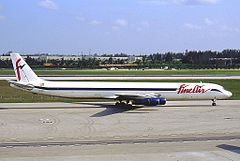Katastrofa lotu Fine Air 101
 DC-8 linii Fine Air, podobny do feralnej maszyny | |
| Państwo | |
|---|---|
| Miejsce | |
| Data | |
| Godzina | 12:36 czasu lokalnego |
| Rodzaj | Zderzenie z ziemią |
| Przyczyna | Przesunięcie ładunku, przeciągnięcie |
| Ofiary | 5 osób |
| Ocaleni | 0 osób |
| Statek powietrzny | |
| Typ | |
| Użytkownik | Fine Air |
| Numer | N27UA |
| Start | |
| Cel lotu | |
| Numer lotu | 101 |
| Pasażerowie | 0 osób |
| Załoga | 3 osoby |
| Ofiary | 5 osób |
| Ocaleni | 0 osób |
Katastrofa lotu Fine Air 101 – katastrofa lotnicza, która wydarzyła się 7 sierpnia 1997 roku, tuż po starcie z międzynarodowego lotniska w Miami. Kilka sekund po osiągnięciu prędkości V1, DC-8 linii Fine Air wysoko zadarł dziób i rozbił się, zabijając 3 członków załogi oraz dwie osoby na ziemi.
Samolot
Samolotem, który uległ katastrofie, był 29-letni McDonnell Douglas DC-8 należący do towarowej linii lotniczej Fine Air. Posiadał numery rejestracyjne N27UA.
Przebieg katastrofy
DC-8 rozpoczął rozbieg na pasie 27R (dzisiejszy 26L) o godzinie 12:34 czasu lokalnego. Po osiągnięciu prędkości V1 piloci standardowo wystartowali, jednak tuż po starcie samolot zaczął wysoko podnosić dziób. W końcu samolot tak bardzo zwolnił, że doszło do przeciągnięcia. Kapitan zwiększył moc silników i próbował opuścić nos, mimo to samolot zaczął opadać. Maszyna już po kilku sekundach rozbiła się na ruchliwej ulicy zabijając wszystkich na pokładzie oraz dwie osoby na ziemi[1].
Przyczyny wypadku
Narodowa Rada Bezpieczeństwa Transportu (NTSB) wydała oficjalny raport w 1998 roku. Opisała w nim, że przyczyną wypadku był źle rozmieszczony ładunek, który spowodował przesunięcie się środka ciężkości. Odkryto również, że samolot był przeciążony o ponad 2,7 tony. Przez to maszyna za bardzo podniosła dziób i runęła na ziemię.
Zobacz też
- Katastrofa lotu Emery Worldwide 17
- Katastrofa lotu Air Midwest 5481
- Katastrofa lotu National Airlines 102
- Katastrofa lotu Arrow Air 1285
Przypisy
- ↑ Harro Ranter, ASN Aircraft accident McDonnell Douglas DC-8-61F N27UA Miami International Airport, FL (MIA), aviation-safety.net [dostęp 2021-05-29].
Media użyte na tej stronie
Autor: Uwe Dedering, Licencja: CC BY-SA 3.0
Location map of the USA (without Hawaii and Alaska).
EquiDistantConicProjection:
Central parallel:
* N: 37.0° N
Central meridian:
* E: 96.0° W
Standard parallels:
* 1: 32.0° N * 2: 42.0° N
Made with Natural Earth. Free vector and raster map data @ naturalearthdata.com.
Formulas for x and y:
x = 50.0 + 124.03149777329222 * ((1.9694462586094064-({{{2}}}* pi / 180))
* sin(0.6010514667026994 * ({{{3}}} + 96) * pi / 180))
y = 50.0 + 1.6155950752393982 * 124.03149777329222 * 0.02613325650382181
- 1.6155950752393982 * 124.03149777329222 *
(1.3236744353715044 - (1.9694462586094064-({{{2}}}* pi / 180))
* cos(0.6010514667026994 * ({{{3}}} + 96) * pi / 180))
The flag of Navassa Island is simply the United States flag. It does not have a "local" flag or "unofficial" flag; it is an uninhabited island. The version with a profile view was based on Flags of the World and as a fictional design has no status warranting a place on any Wiki. It was made up by a random person with no connection to the island, it has never flown on the island, and it has never received any sort of recognition or validation by any authority. The person quoted on that page has no authority to bestow a flag, "unofficial" or otherwise, on the island.
The flag of the Dominican Republic has a centered white cross that extends to the edges. This emblem is similar to the flag design and shows a bible, a cross of gold and 6 Dominican flags. There are branches of olive and palm around the shield and above on the ribbon is the motto "Dios,Patria!, Libertad" ("God, Country, Freedom") and to amiable freedom. The blue is said to stand for liberty, red for the fire and blood of the independence struggle and the white cross symbolized that God has not forgotten his people. "Republica Dominicana". The Dominican flag was designed by Juan Pablo Duarte, father of the national Independence of Dominican Republic. The first dominican flag was sewn by a young lady named Concepción Bona, who lived across the street of El Baluarte, monument where the patriots gathered to fight for the independence, the night of February 27th, 1844. Concepción Bona was helped by her first cousin María de Jesús Pina.
Autor:






